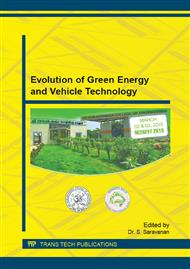[1]
S. Murugan, M.R.C. Ramaswamy, G. Nagarajan, Influence of distillation on performance, emission, and combustion of a DI diesel engine, using tyre pyrolysis oil diesel bends, Therm. Sci. 12 (2008), 157-167.
DOI: 10.2298/tsci0801157m
Google Scholar
[2]
G. Vellguth, Performance of vegetable oils and their monoesters as fuels for diesel engines, SAE 831358.
DOI: 10.4271/831358
Google Scholar
[3]
A. Srivastava, R. Prasad, Triglycerides- based diesel fuels, Renew. Sust. Energ. Rev., 4 (2000), 111-133.
Google Scholar
[4]
Ma. Fangrui, A. Milford, Biodiesel production a review, Bioresour. Technol. 70 (1999), 1-15.
Google Scholar
[5]
B. Freedman, E.H. Pryde, T.L. Mounts, Variables affecting the yields of fatty esters from transesterified vegetable oils, J. Am. Oil Chem. Soc. 61 (1984), 1638-1643.
DOI: 10.1007/bf02541649
Google Scholar
[6]
L.A. Nelson, T.A. Foglia, W.N. Marmer, Lipase-catalyzed production of biodiesel, J. Am. Oil Chem. Soc. 73 (1996), 1191-1195.
DOI: 10.1007/bf02523383
Google Scholar
[7]
H. Fukuda, A. Konda, H. Noda, Biodiesel fuel production by transesterification of oils, J. Biosci. Bioeng. 92, (2001, 405-416.
Google Scholar
[8]
R. Alcantara, J. Amores, L. Canoira, E. Fidalgo, M.J. Franco, A. Navarro, Catalytic production of biodiesel from soybean oil, used frying oil and tallow, Biomass Bioenergy, 18 (2000), 515-527.
DOI: 10.1016/s0961-9534(00)00014-3
Google Scholar
[9]
P.R. Muniyappa, S.C. Brammer, H. Noureddini, Improved conversion of plant oils and animal fats into biodiesel and co-product, Bioresour. Technol. 56 (1996), 19-24.
DOI: 10.1016/0960-8524(95)00178-6
Google Scholar
[10]
G. Antolı́na, F.V. Tinautb, Y. Briceñoc, V. Castañoc, C. Pérezb, A.I. Ramı́rezc, Optimization of biodiesel production by sunflower oil transesterification, Bioresour. Technol. 83 (2002), 111-114.
Google Scholar
[11]
M. Senthilkumar, A. Ramesh, B. Nagalingam, n experimental comparison of methods to use methanol and jatropha oil in a compression ignition engine, Biomass Bioenergy, 25 (2003), 309-318.
DOI: 10.1016/s0961-9534(03)00018-7
Google Scholar
[12]
T. Ganapathy, R.P. Gakkhar, K. Murugesan, An analytical and experimental study of performance on jatropha biodiesel engine, Therm. Sci. 13(2009), 69-82.
DOI: 10.2298/tsci0903069g
Google Scholar
[13]
D.A. Dhananjaya, C.V. Sudhir, P. Mohanan, Combustion characteristics of diesel engine operating on jatropha oil methyl ester, Therm. Sci. 14 (2010), 965-977.
DOI: 10.2298/tsci1004965d
Google Scholar
[14]
S. Puhan, N. Vedaraman, G. Sankaranarayanan, B.V. Ramabrahmam, Performance and emission study of mahua ethyl ester in a four stroke direct injection diesel engine, Renew. Energ. 30 (2005) 1269-1278.
DOI: 10.1016/j.renene.2004.09.010
Google Scholar
[15]
H. Raheman, A.G. Phadatare, Diesel engine emissions and performance from blends of karanja methyl ester and diesel, Biomass Bioenerg. 27 (2004), 393-397.
DOI: 10.1016/j.biombioe.2004.03.002
Google Scholar
[16]
S. Kaliamoorthy, R. Paramasivam, Investigation on performance and emissions of a biodiesel engine through optimization techniques, Therm. Sci. 17 (2013), 179-193.
DOI: 10.2298/tsci120105151k
Google Scholar
[17]
A.S. Ramadhas,C. Muraleedharan, S. Jayaraj, Performance and emission evaluation of a diesel engine fueled with methyl esters of rubber seed oil, Renew. Energ. 30 (2005), 1700-1789.
DOI: 10.1016/j.renene.2005.01.009
Google Scholar
[18]
S. Sinha, S, A.K. Agarwal, Combustion characteristics of rice bran oil derived biodiesel in a transportation diesel engine, SAE 2005-26-354.
DOI: 10.4271/2005-26-354
Google Scholar
[19]
G.L.N. Rao, S. Sravanan, S. Sampath, K. Rajagopal, Combustion and emission characteristics of diesel engine fuelled with rice bran oil methyl ester and its diesel blends, Therm. Sci., 12 (2008), 139-150.
DOI: 10.2298/tsci0801139g
Google Scholar
[20]
N. Hernandez, Enzymatic treatment of rice bran to improve processing, J. Am. Oil Chem. Soc. 77 (2000), 177-180.
Google Scholar
[21]
S. Sivalakshmi,T. Balusamy, Experimental investigation on a diesel engine fuelled with neem oil and its methyl ester, Therm. Sci. 15 (2011), 1193-1204.
DOI: 10.2298/tsci100810054s
Google Scholar
[22]
J.P. Holman, Experimental Methods for Engineers, sixth ed., McGraw Hill, Inc., (1994).
Google Scholar
[23]
N.J. Barsic, A. Humkeai, Performance and emission characteristics of a naturally aspirated diesel engine with vegetable oil fuels, SAE 810262.
DOI: 10.4271/810262
Google Scholar
[24]
S.J. Clark, L. Wagner, M.D. Schrock, P.G. Piennaar, Methyl and ethyl soybean ester as renewable fuels for diesel engines, J. Am. Oil Chem. Soc 61 (1984), 1632-1637.
DOI: 10.1007/bf02541648
Google Scholar
[25]
Y. Kidoguchi, Y. Yang, K. Miwa, Effects of fuel properties on combustion and emission characteristics of a direct injection diesel engine, SAE 2000-01-1831.
DOI: 10.4271/2000-01-1851
Google Scholar
[26]
M. Gumus, A comprehensive experimental investigation of combustion and heat release characteristics of a biodiesel (hazelnut kernel oil methyl ester) fueled direct injection compression ignition engine, Fuel 89, (2010), 2802-2814.
DOI: 10.1016/j.fuel.2010.01.035
Google Scholar
[27]
S. Sinha, A.K. Agarwal, Experimental investigation of the combustion characteristics of a biodiesel (rice-bran oil methyl ester)-fuelled direct-injection transportation diesel engine, Proc. IMechE Vol. 221 Part D: J. Auto Engg., Special Issue Paper, 921-932.
DOI: 10.1243/09544070jauto220
Google Scholar
[28]
B. Kegl, A. Hribernik, Experimental analysis of injection characteristics using biodiesel fuel, Energy Fuels 20 (2006), 2239–2248.
DOI: 10.1021/ef060285m
Google Scholar


